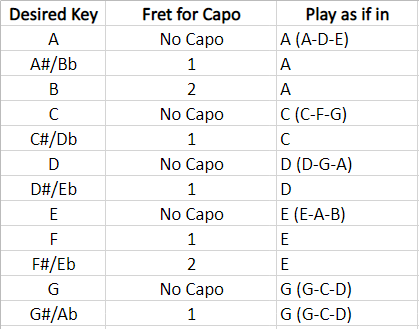

Lesson 7: How to Use a Capo
The capo can be useful, but confusing if you try to overdo it. Here are some practical suggestions.
There are basically two situations where a capo is used.
First it is used to allow you to play in keys you are not famliar with. For example, if a song is being played in the key of B and you are not familiar with that key you can put a capo on fret 2 and play as though you are in the key of A. This goes for all other keys you don't normally play in: keys such as Eb, C#, Db and so on.
Second, you can use a capo to allow you to play certain fingering and chording shapes where you prefer the way that fingering sounds. For example, the song "Here Comes the Sun" is usually played in the key of A, but sounds better if you put a capo on the 7th fret and play as if you are in D.
In this lesson we provide you with a guide for using the capo in the first way: to play in keys you are not familiar with.
Some Practical Guidelines for Using the Capo
The chart below gives you the most straightforward way to use your capo. To use this chart you need to understand that there are two groups of keys. First, there are the ones most guitar players are familiar with: G, A, C, D, and E.
Second, there are the "other ones".
The chart shows how to use the first group along with a capo to play the second group
Here is the way it works. The first column indicates the desired key. The second column indicates where to put the capo. And the third column tells you which key to play as if you are in.

Capo Strategy
Once you know which key you want to play in, it is usually just a matter of *finding the familiar key that is the closest below the desired one. So the steps are as follows:
- Figure out the desired key. (*See below for a simple technique for figuring out what key a song is in.)
- Find the next lowest familiar key. For example if the desired key is C#, the next lowest familiar key is C (just one fret below C#).
- Put the capo on the appropriate fret.
- Play as if you are in the next lowest familiar key
*Figuring Out the Key of Your Song
Most popular or traditional songs end on the root note of the major scale they are written in. We'll call this the "anchor tone" around which the song is built. Many phrases within these songs also end on the same anchor or root note. This is the "key" of the song.
Play the song (or listen to it being played. Listen carefully to the way major phrases or sections of the song end. In particular listen to the note that the song ends on.
In the example given here, "Twinkle, Twinkle Little Star" notice how the line "How I wonder what you are" sounds like the distinctive end of a section. The final note of this section is the root or anchor tone you are looking for. If you are not sure, listen or hum to the end of the song. The same line is repeated, with the same result, namely that it ends on the root of the major scale.
That tells you the key you are looking for.
If it turns out to be the 4th fret of the B-string that means it is in the key of Eb or D#. The chart says to put the capo on the first fret and play as though you are playing in D.
Here is another example, the song "By The Rivers of Babylon". The verse of the song consists of chunks of four phrases. The fourth is clearly the end of the section. The words are "when we remembered Zion." This phrase ends on the root note or anchor tone of the song, and that tells you the key it is being played in.
Once you discover the anchor tone, be sure to HUM it so you clearly hear what it sounds like. Now figure out what note it is by pecking around on the guitar. It is best to restrict your pecking to the G and B strings. If you find it is the open G string you know it is a G and you don't need a capo.
If it turns out to be the 4th fret of the G-string that is a B. Our chart says to put the capo on fret 2 and play as if you are in the key of A.
That’s it!! Now try it here to prove it to yourself.
